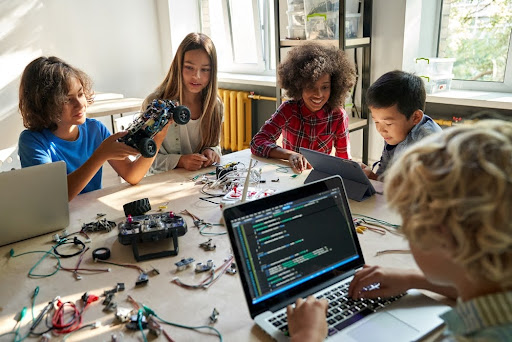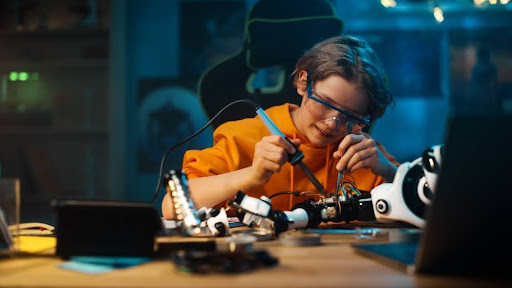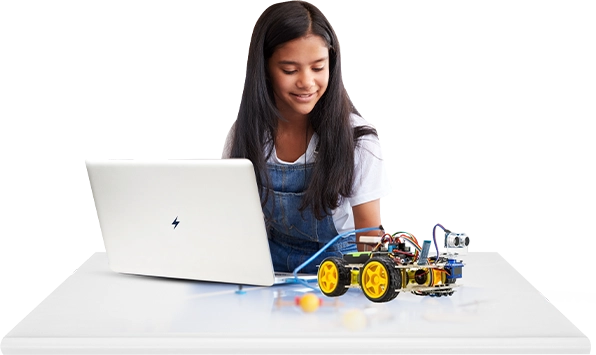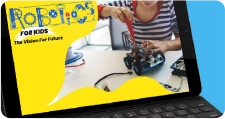Robotics is a fascinating field that encourages creativity, problem-solving, and technical skills. Introducing robotics to kids as young as 7 or 8 years old can be an exciting way to spark curiosity about STEM (Science, Technology, Engineering, and Mathematics). In this guide, we’ll cover everything from the basics of robotics to fun activities, projects, and competitions that will engage young learners in this amazing world.
What Are Robots?
A robot is a machine that can perform tasks automatically. It can be programmed to do specific actions based on instructions, whether it’s moving, lifting objects, or even exploring new places. Roboics games can be controlled remotely, or they can work independently after being programmed.
What Is Robotics?
Robotics is the branch of technology that deals with the design, construction, operation, and use of robots. It combines various fields, including mechanical engineering, electrical engineering, and computer science. Essentially, robotics is the science of building and programming robots to carry out tasks—sometimes tasks that are too dangerous, repetitive, or complex for humans.
Why Teach Robotics to Kids?

Robotics for kids at an early age has numerous benefits. It encourages hands-on learning and enhances skills like:
- Problem-Solving: Robotics challenges kids to think critically about how to solve problems.
- Creativity: As they design and build robots, kids engage their creative side.
- Collaboration: Many robotics activities are team-based, helping kids develop teamwork and communication skills.
- Coding Skills: Robotics introduces kids to basic coding and programming logic, giving them a head start in today’s tech-driven world.
- Confidence: Successfully building and programming a robot can boost a child’s self-esteem and confidence.
What to Teach in Robotics?
When introducing robotics to children ages 7-8, focus on the basics and build their knowledge step by step:
- Basic Concepts: Teach them what robots are and how they work.
- Programming Logic: Introduce basic coding principles through visual coding languages like Blockly or ScratchJr.
- Problem-Solving: Use fun challenges that require kids to program robots to complete tasks, such as following a line or navigating an obstacle course.
- Robot Components: Teach about the different parts of a robot, like sensors, motors, and controllers.
- Robot Types: Explore the different kinds of robots, such as humanoid robots, robotic arms, and automated vehicles.
How to Teach Robotics?

When teaching robotics to kids, it’s essential to make it fun, interactive, and hands-on. Here’s how:
- Use Robotics Kits: Hands-on robotics kits like LEGO WeDo, Botley 2.0, or Sphero Mini can help children learn about robotics in a fun and interactive way.
- Break It Down: Start with simple concepts and gradually introduce more complex ideas as their skills grow.
- Incorporate Games: Challenge your kids with robotics games and puzzles. Create obstacle courses or races that involve programming the robot to complete specific tasks.
- Encourage Exploration: Let kids experiment with different robot designs and programming commands. This encourages creative thinking and problem-solving.
- Make It Visual: Use visual programming tools like Blockly or ScratchJr to teach coding. These tools use a drag-and-drop interface that simplifies coding logic.
5 Activities to Teach Robotics

Here are five fun activities you can do with kids to teach robotics:
- Build and Program a Simple Robot: Using a LEGO WeDo kit or similar, have kids build and program their first robot. This activity teaches them how robots move and interact with their environment.
- Obstacle Course Challenge: Set up an obstacle course for a robot to navigate. Kids will need to program the robot to avoid obstacles, which helps develop their problem-solving and coding skills.
- Robot Drawing: Have kids program a robot (like a Sphero) to draw shapes or patterns on paper. This combines creativity with robotics.
- Robot Storytelling: Create a story where the robot is a character, and kids need to program it to complete tasks as part of the narrative.
- Robot Race: Set up a racecourse for robots and challenge kids to program their robots for speed and accuracy.
10 Robotics Projects for Kids
- Build a Robot Arm: Introduce mechanical movements with a simple robotic arm that can pick up small objects.
- Line Following Robot: Program a robot to follow a line on the floor.
- Maze Solving Robot: Challenge kids to create a robot that can navigate through a maze.
- Robotic Pet: Build a robot that can react to touch or sound.
- Robotic Car: Create a simple robotic car that can drive forward, backward, and turn.
- Rube Goldberg Machine: Incorporate robotics into a fun Rube Goldberg-style project where robots complete a series of steps to achieve a task.
- Robotic Assistant: Build a robot that can follow simple voice or motion commands.
- LED Light Robot: Program a robot to light up LEDs in different patterns.
- Ball-and-Chain Robot: Create a robot with an attached ball that can roll and move in interesting ways.
- Robotic Arm that Draws: Teach kids how to build a robotic arm that can draw pictures or patterns.
Top Robotics Competitions for Kids
Getting kids involved in robotics competitions can be a great way to apply what they’ve learned and push their skills further. Here are some of the top competitions for younger students:
- FIRST LEGO League Jr.: This competition is designed for children ages 6-10 and introduces them to basic robotics concepts in a fun, team-based environment.
- VEX Robotics Competitions: These competitions are aimed at kids ages 8-14, and they focus on creating robots to perform specific tasks in a competitive setting.
- RobotChallenge: A global robotics competition where kids can compete by programming robots to solve various tasks.
- Best Robotics: A program that engages students in building and programming robots to complete challenges.
Importance of Robotics in the Future
The future of robotics is incredibly exciting, and teaching robotics to kids today sets them up for success in tomorrow’s world. Robotics is playing a growing role in industries such as healthcare, manufacturing, entertainment, and space exploration. By learning robotics, kids develop critical thinking, coding, and engineering skills that will be valuable in future careers. Additionally, robots are expected to continue revolutionizing our daily lives, making robotics an essential part of the future workforce.
Final Thoughts
Introducing robotics to kids ages 7-8 is an exciting journey that fosters creativity, problem-solving, and technical skills. Through fun activities, hands-on projects, and competitions, children can explore the fascinating world of robots while developing valuable skills for their future. By starting early, kids will not only enjoy learning but also gain the knowledge that can lead to a lifelong interest in STEM fields.
Start with simple robotics projects today and watch your child’s imagination take flight as they begin their robotics adventure!
Moonpreneur is disrupting traditional education and future-proofing the next generation with its holistic learning solutions. Its Innovator Program is building the workforce of the future through the training of students in AI/ML, Robotics, Coding, IoT, and Apps, thereby empowering entrepreneurship through experiential learning.
FAQs About Teaching Robotics to Kids
Some great beginner-friendly kits include LEGO WeDo, Botley 2.0, Ozobot, and Sphero Mini, which help kids learn robotics through play.
Starting with 30–60 minutes per session, 2–3 times a week, can help maintain engagement while allowing time for hands-on learning.
Absolutely! Parents and siblings can join in building and programming robots, making it a great way to bond and learn together.
Yes! Most beginner robotics kits are designed with child safety in mind, using large, non-toxic parts and simple, screen-free programming options.
Encourage hands-on projects, real-world applications, STEM competitions, and interactive storytelling to keep learning fun and engaging.
Definitely! Robotics teaches problem-solving, coding, and engineering concepts, which are essential skills for future STEM careers.
Robotics combines science, technology, engineering, and math (STEM), while also encouraging creativity, problem-solving, and logical thinking.
Yes! Events like FIRST LEGO League, VEX IQ Challenge, and RoboCup Junior offer exciting opportunities for kids to showcase their robotics skills.
Consider your child’s age, skill level, and interests. Look for kits with easy-to-follow instructions, hands-on activities, and gradual learning progressions.
Yes! Robotics can enhance learning for children with autism, ADHD, and other challenges by improving focus, social skills, and hands-on engagement.
























